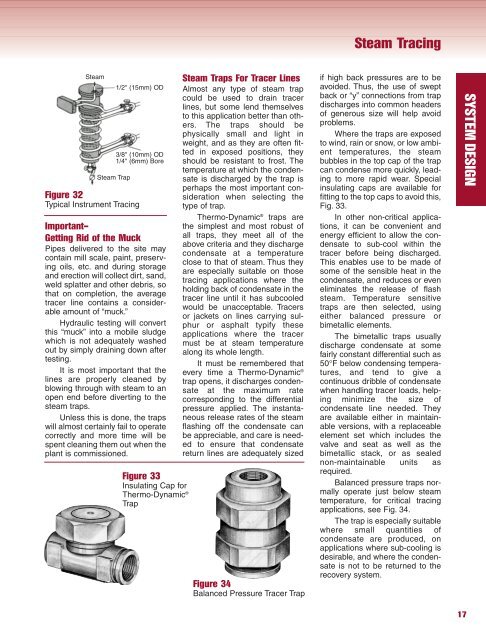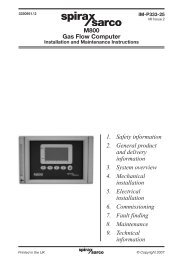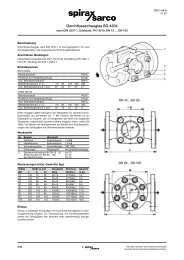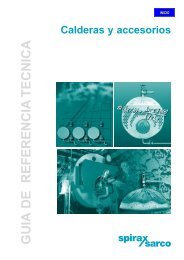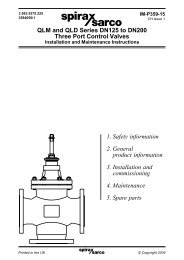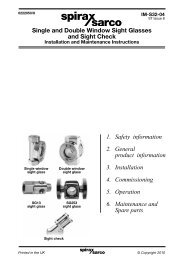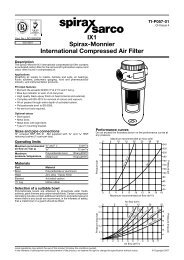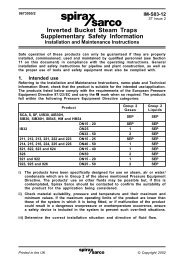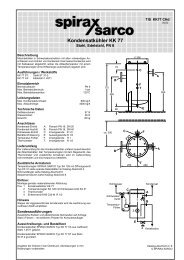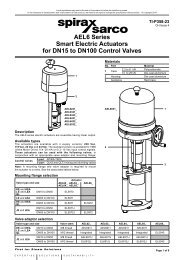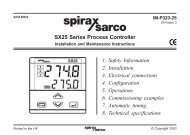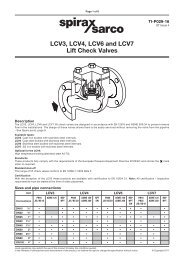2000 Hook-up Book - Spirax Sarco
2000 Hook-up Book - Spirax Sarco
2000 Hook-up Book - Spirax Sarco
Create successful ePaper yourself
Turn your PDF publications into a flip-book with our unique Google optimized e-Paper software.
Steam<br />
Steam Trap<br />
1/2" (15mm) OD<br />
3/8" (10mm) OD<br />
1/4" (6mm) Bore<br />
Figure 32<br />
Typical Instrument Tracing<br />
Important—<br />
Getting Rid of the Muck<br />
Pipes delivered to the site may<br />
contain mill scale, paint, preserving<br />
oils, etc. and during storage<br />
and erection will collect dirt, sand,<br />
weld splatter and other debris, so<br />
that on completion, the average<br />
tracer line contains a considerable<br />
amount of “muck.”<br />
Hydraulic testing will convert<br />
this “muck” into a mobile sludge<br />
which is not adequately washed<br />
out by simply draining down after<br />
testing.<br />
It is most important that the<br />
lines are properly cleaned by<br />
blowing through with steam to an<br />
open end before diverting to the<br />
steam traps.<br />
Unless this is done, the traps<br />
will almost certainly fail to operate<br />
correctly and more time will be<br />
spent cleaning them out when the<br />
plant is commissioned.<br />
Figure 33<br />
Insulating Cap for<br />
Thermo-Dynamic ®<br />
Trap<br />
Steam Traps For Tracer Lines<br />
Almost any type of steam trap<br />
could be used to drain tracer<br />
lines, but some lend themselves<br />
to this application better than others.<br />
The traps should be<br />
physically small and light in<br />
weight, and as they are often fitted<br />
in exposed positions, they<br />
should be resistant to frost. The<br />
temperature at which the condensate<br />
is discharged by the trap is<br />
perhaps the most important consideration<br />
when selecting the<br />
type of trap.<br />
Thermo-Dynamic ® traps are<br />
the simplest and most robust of<br />
all traps, they meet all of the<br />
above criteria and they discharge<br />
condensate at a temperature<br />
close to that of steam. Thus they<br />
are especially suitable on those<br />
tracing applications where the<br />
holding back of condensate in the<br />
tracer line until it has subcooled<br />
would be unacceptable. Tracers<br />
or jackets on lines carrying sulphur<br />
or asphalt typify these<br />
applications where the tracer<br />
must be at steam temperature<br />
along its whole length.<br />
It must be remembered that<br />
every time a Thermo-Dynamic ®<br />
trap opens, it discharges condensate<br />
at the maximum rate<br />
corresponding to the differential<br />
pressure applied. The instantaneous<br />
release rates of the steam<br />
flashing off the condensate can<br />
be appreciable, and care is needed<br />
to ensure that condensate<br />
return lines are adequately sized<br />
Figure 34<br />
Balanced Pressure Tracer Trap<br />
Steam Tracing<br />
if high back pressures are to be<br />
avoided. Thus, the use of swept<br />
back or “y” connections from trap<br />
discharges into common headers<br />
of generous size will help avoid<br />
problems.<br />
Where the traps are exposed<br />
to wind, rain or snow, or low ambient<br />
temperatures, the steam<br />
bubbles in the top cap of the trap<br />
can condense more quickly, leading<br />
to more rapid wear. Special<br />
insulating caps are available for<br />
fitting to the top caps to avoid this,<br />
Fig. 33.<br />
In other non-critical applications,<br />
it can be convenient and<br />
energy efficient to allow the condensate<br />
to sub-cool within the<br />
tracer before being discharged.<br />
This enables use to be made of<br />
some of the sensible heat in the<br />
condensate, and reduces or even<br />
eliminates the release of flash<br />
steam. Temperature sensitive<br />
traps are then selected, using<br />
either balanced pressure or<br />
bimetallic elements.<br />
The bimetallic traps usually<br />
discharge condensate at some<br />
fairly constant differential such as<br />
50°F below condensing temperatures,<br />
and tend to give a<br />
continuous dribble of condensate<br />
when handling tracer loads, helping<br />
minimize the size of<br />
condensate line needed. They<br />
are available either in maintainable<br />
versions, with a replaceable<br />
element set which includes the<br />
valve and seat as well as the<br />
bimetallic stack, or as sealed<br />
non-maintainable units as<br />
required.<br />
Balanced pressure traps normally<br />
operate just below steam<br />
temperature, for critical tracing<br />
applications, see Fig. 34.<br />
The trap is especially suitable<br />
where small quantities of<br />
condensate are produced, on<br />
applications where sub-cooling is<br />
desirable, and where the condensate<br />
is not to be returned to the<br />
recovery system.<br />
17<br />
SYSTEM DESIGN


